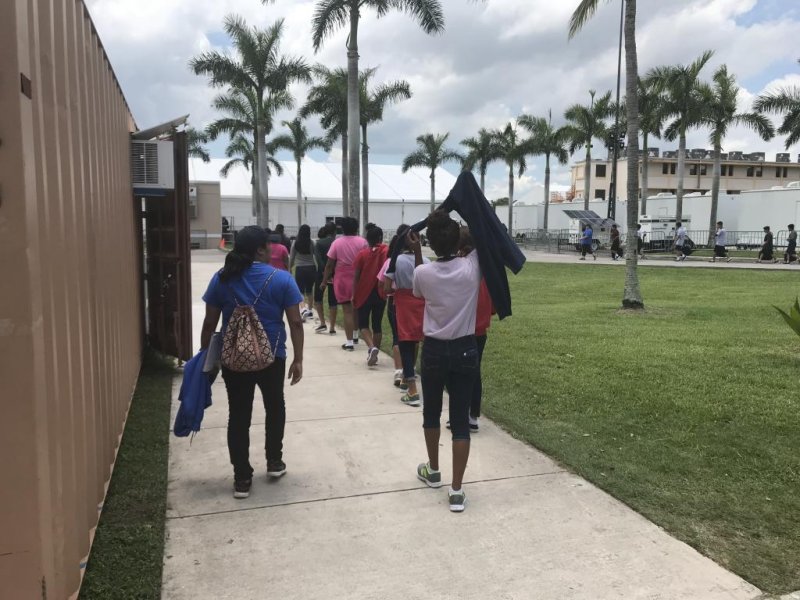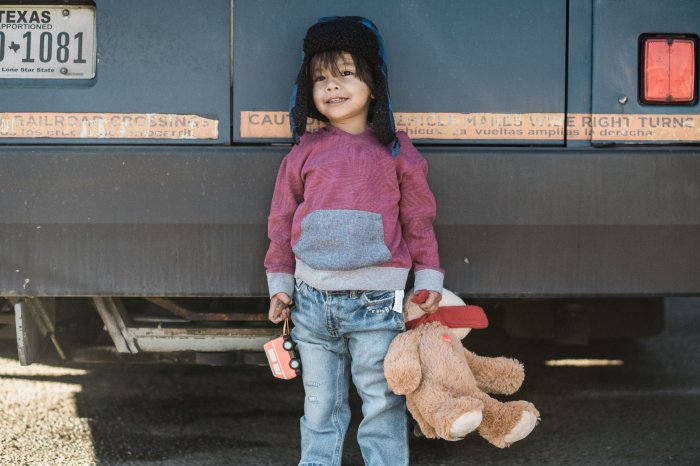1 of 3 | Children walk between buildings at a temporary emergency shelter in Homestead, Fla., where 1,575 children who entered the United States without their parents are presently being sheltered. Photo courtesy HHS
Feb. 13 (UPI) -- A month after federal officials removed the last child from a facility in Texas, 1,600 unaccompanied migrant children are being housed at a so-called temporary emergency shelter in Florida.
The U.S. Department of Health and Human Services invited UPI and other media on Wednesday to tour the facility in Homestead, Fla., which is located in a former Job Corps facility near the Homestead Air Reserve Base. It is used as a shelter for what HHS calls "unaccompanied alien children," or UAC -- migrants between the ages of 13 and 17 who have no lawful immigration status and no legal guardians able to provide care in the United States.
Since March 2018 more than 6,000 children have been placed at the site and about 4,450 have been discharged to what the department considers suitable sponsors -- generally a parent or some other relative -- in the United States, according to HHS.
At the time of UPI's visit, 1,575 children were being sheltered at the facility -- 1,143 males and 432 females.
All the migrant children placed at the Homestead facility are in the custody of HHS, though the agency states it does not play a role in apprehension or initial detention of the children nor is it involved in caring for them before their referral.
"Most UAC are referred to [the Office of Refugee Resettlement] by the Department of Homeland Security," HHS states. "Some UAC may be referred to ORR because they were apprehended by immigration authorities while trying to cross the border. Others are referred after coming to the attention of DHS in the interior of the United States."
Overall, HHS operates more than 100 shelters in 17 states, including two other permanent shelters in Florida, and 49,000 children have been referred to the program since 2018.
Coming and going
Throughout the more than 100 shelters in the program nationally, approximately 200 children are received and 200 children are discharged on any given day. HHS spokesman Mark Weber told reporters that 243 children were received and 114 were discharged nationwide Tuesday and 201 were received versus 230 discharged Monday.
The program coordinator for the Homestead facility said the majority of children sheltered there came to the United States from Guatemala, Honduras and El Salvador. Most of the facility's population is children from Guatemala.
Weber said none of the children currently sheltered in the Homestead facility was separated from their parents as a result of the Trump administration's "zero-tolerance" immigration policy.
Weber also said none of the children at the facility was transferred from the recently closed facility in Tornillo, Texas.
Children remain at the HHS facilities until they are released to a suitable sponsor or when they reach the age of 18.
In 2018, 42 percent of children admitted to HHS shelters nationwide were placed with parents in the United States; 47 percent were placed with close relatives, such as an aunt, uncle or cousin, and 11 percent were placed with distant relatives, such as a second cousin.
All potential sponsors are required to undergo background checks and the ORR requires home studies for children who are victims of physical or sexual abuses or whose sponsor "clearly presents a risk" of abuse maltreatment, exploitation or trafficking. Home studies are also required for any child sent to a non-relative sponsor who is seeking to sponsor multiple children or has previously sponsored a child and seeks to sponsor additional children.
In December, the HHS rescinded a policy requiring all household members to submit to fingerprint background checks.
On average, children spend 67 days in care at the Homestead, while the program-wide average is 60 days.
Children who turn 18 while in custody at a shelter are considered undocumented immigrants and are released to authorities, Weber said.
There were 21 such cases at the Homestead facility last month and 90 in the past year, the Homestead program coordinator said.
A team of case managers at the facility focuses on finding sponsors for children within three months of their 18th birthday and the program coordinator receives daily reports regarding their status in the two weeks before those children turn 18.
Life at the shelter
Upon arriving at the facility in Homestead, children are examined in medical trailers where they are given X-rays, necessary vaccinations and tests for tuberculosis and other diseases.
Girls older than 10 are administered pregnancy tests and children who are pregnant, diagnosed with an illness or any other special need are transferred to a separate medical facility to accommodate them.
Children who remain at the facility are provided a hygiene kit and clothing including underwear, shirts sweatpants, sweaters, jeans and shoes in a black duffle bag. Girls are also given a bra and sanitary napkins.
They then live in one of two campuses, where they sleep, attend school five days a week, receive regular medical care and participate in talent shows and other activities.
The south campus houses 905 children between the ages of 13 and 16, including 634 males and 271 females, while all 17-year-olds at the facility live on the north campus, which houses 509 males and 161 females.
At the south campus, children are housed in dormitory buildings with rooms that feature 12 beds -- six twin bunkbeds -- one shared shower and two sinks. There are also smaller rooms with four beds where children who are pregnant, injured or in other special cases sleep. A staff member is assigned to sit outside each room and monitor the children.
Each dormitory on the south campus has 12 rooms per floor for a total of 424 beds per building.
The north campus dormitories feature larger base-style bedrooms with 144 beds per room, which the program coordinator said the older children requested as a opposed to the smaller dorms.
Both dormitories are permanent concrete structures, but the bathrooms at the north campus dorms are white, semi-permanent, tent-like structures attached to the dorms through a hallway. These bathrooms feature stall toilets and showers as well as hand-washing stations.
Both campuses are separated by gender.
Children wake up 6 a.m. and spend an hour showering, brushing their teeth and doing chores before beginning daily classes at 7 a.m., which are also separated by campus, age and gender.
The students attend classes including social studies, math, science, reading and writing, as well as English for speakers of other languages classes in air-conditioned, tent-like buildings from 7 a.m. to 5:30 p.m. They also attend vocational school three times per week during this period.
There are 30 classrooms on the south campus with an average class size of 36 to 48 students, supervised by five adults including a teacher. The south campus has 48 teachers and the north has 42 teachers.
Children are served breakfast, lunch and dinner as well as three snacks in a concrete dining hall each day. Boys and girls have different meal times and menu items include a mix of American foods and foods common in their native countries.
Children participate in physical education courses and are granted outdoor recreation time on the soccer fields, and basketball and volleyball courts on campus.
On weekends, children participate in other activities such as religious services, movies and talent shows, and monthly holiday parties are held in a large multi-purpose tent that is also air-conditioned. The tent is also used for child admissions.
After school and dinner time, children are given about 3 and one-half hours of arts and crafts and recreation time before bed at 10 p.m.
The facility also features a medical center where children can be treated by four physicians, one of whom is a woman, and around-the-clock care from nurses and other medical staff. The medical staff complies with regulations requiring one clinician for every 12 children, the program coordinator said.
The medical center includes overnight rooms for children exhibiting flu or strep throat symptoms and, if needed, medical staff will seek external specialists or transfer children to the nearby Homestead Baptist Hospital.
Operating the facility
As a temporary emergency shelter, the Homestead facility is on federal land and therefore it is not subject to certification by state authorities responsible for regulating facilities that house children.
Following the closure of the shelter in Tornillo, Texas, the Homestead facility is the only temporary emergency shelter in the United States. Such shelters are unlicensed facilities on federal land that provide temporary shelter and services for children when licensed facilities are near or at capacity.
The use of temporary emergency shelters was established after HHS ran out of space to shelter children in 2014 and thousands of unaccompanied minors were held at border patrol facilities, Weber said.
HHS sheltered more than 8,500 children at the Homestead facility from June 2016 to April 2017 and the facility was then closed until February 2018.
The property was provided to HHS by the U.S. Department of Labor and the two departments presently have a licensing agreement through June 2019. The facility will be returned to the Department of Labor upon its request, HHS said.
As of Dec. 25, the shelter operated at a maximum capacity of about 1,350 beds, with 1,300 children housed at the shelter during that time -- 69 percent males and 31 percent females.
The shelter began to expand to its current capacity of 1,600 in January, with the option to increase to up to 2,350 beds in increments of 250 depending on need, HHS. An additional 230 people were hired since December to accommodate the expansion.
Weber said it costs $250 per-child to operate a permanent facility for migrant children each day, while it costs $750 per-child each day to operate the Homestead facility. At its current capacity, it costs $438 million to run the Homestead facility each year.
"When there are no children here, we're still paying because we want to maintain the facility. When we have to stand up a facility quickly it takes a lot of resources," Weber said. "So it is expensive, but it is better than children being backed up at border patrol facilities."
The Tornillo facility discharged its last child on Jan. 11 after scaling down from a high of nearly 3,000 migrant children, beginning in December, amid calls from activists and politicians to shut the shelter down.
"We were able to close Tornillo because we didn't need it anymore," Weber said. "The good news is we were able to get kids out of our care and released to a suitable sponsor."
About 80 percent of children sheltered at Tornillo were sent to suitable sponsors, while the remaining 20 percent were sent to other permanent shelters, according to Weber.
He added that the need for temporary shelters has been reduced due to a lower number of incoming unaccompanied migrant children and the change in fingerprinting requirements for sponsors, which, when used, increases the amount of time children spend at shelters before being discharged.
Weber noted that if the need for temporary shelters continues to decrease, the Homestead facility could be closed again.
"We're hopeful if children don't come at an incredibly high rate that this shelter will be able to shut down and we would run again with our standard shelters across the country," he said.
Children of the Central American migrant caravan
<< Show Caption >>
















